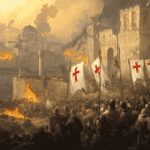
Few organizations in history have captivated the imagination as much as the Knights Templar. Rising from humble origins in the early 12th century, they became one of the most powerful military and financial institutions of the medieval world before meeting an infamous and brutal end in the early 14th century. The Templars were warriors, monks, bankers, and administrators, wielding influence that stretched from the battlefields of the Holy Land to the courts of Europe.
Origins and Foundation (1119–1139)
The Order of the Poor Fellow-Soldiers of Christ and the Temple of Solomon – better known as the Knights Templar – was founded in 1119, in the wake of the First Crusade (1096–1099). Nine knights, led by Hugues de Payens, pledged themselves to the service of protecting Christian pilgrims traveling to the newly conquered Holy Land, particularly on the dangerous road from Jaffa to Jerusalem. King Baldwin II of Jerusalem granted them quarters on the Temple Mount, believed to be the site of the biblical Temple of Solomon, lending the knights a sacred aura that helped solidify their identity.

Initially, they were a minor military order, living under a rule of poverty and humility. However, their fortunes changed dramatically in 1129 when Bernard of Clairvaux, a highly influential monk and theologian, threw his support behind them. Bernard, later canonized as a saint, wrote the Liber ad Milites Templi de Laude Novae Militiae (“In Praise of the New Knighthood”), which extolled their unique blend of martial prowess and monastic devotion.
In 1139, Pope Innocent II granted them papal protection through the bull Omne Datum Optimum, giving them unprecedented privileges: they answered only to the Pope, were exempt from taxes, and could cross borders freely. These privileges, combined with their growing reputation, set the stage for their rapid expansion.
The Templars in the Holy Land (12th–13th Century)
The Templars quickly became a key military force in the Crusader states. Unlike ordinary knights, who often fought for personal glory or wealth, the Templars took monastic vows and were committed to their cause with a near-fanatical devotion. Their white mantles with the red cross became symbols of both fear and reverence.
They built an extensive network of castles and fortifications, including the formidable Krak des Chevaliers in modern Syria.
One of the most famous victories of the Knights Templar occurred at the Battle of Montgisard (1177). A vastly outnumbered Crusader force, led by Baldwin IV of Jerusalem, faced off against Saladin’s powerful army. The young Baldwin, suffering from leprosy, was supported by the Templars, whose fierce cavalry charge shattered Saladin’s forces. The Muslim army, unprepared for such a determined assault, was routed, and Saladin himself barely escaped with his life. The victory at Montgisard was a shining moment for the Templars, proving their effectiveness as shock troops and reinforcing their reputation as the defenders of Christendom. The Templars were known for their unwavering discipline; Saladin himself is said to have respected their courage, but also regarded them as his most dangerous adversaries.

Even as the Crusader states weakened, the Templars adapted. They focused on defending remaining strongholds such as Acre, where they held out until the city fell in 1291, marking the end of Christian rule in the Holy Land. With the loss of their primary battlefield, their role as warriors diminished, but their power did not.
The Templars as Medieval Bankers
While the Templars were fearsome warriors, they were also pioneers in finance. Their vast network of castles, commanderies, and estates across Europe and the Middle East allowed them to develop an early form of banking. Pilgrims could deposit money in one Templar house and withdraw it in another, reducing the risk of robbery during their journeys.
The Templars also loaned money to kings, nobles, and even the Pope. Their financial acumen enabled them to amass immense wealth, but it also made them powerful enemies. By the late 13th century, they were not just warriors but major landowners, financiers, and political players in European courts. Their influence was formidable, but it also made them vulnerable.

The Fall of the Templars (1307–1314)
The Templars’ downfall was as spectacular as their rise. By the early 14th century, King Philip IV of France, deeply in debt to the Order, saw an opportunity to eliminate them and seize their wealth. With the help of Pope Clement V, he orchestrated a dramatic crackdown. On Friday, October 13, 1307, hundreds of Templars across France were arrested in a coordinated operation. This event, occurring on a Friday the 13th, is often cited as the origin of the superstition surrounding that date.
The charges against the Templars were shocking: heresy, blasphemy, idol worship, sodomy, and financial corruption. Under torture, many knights confessed, though these admissions were coerced. The most infamous charge was that they worshiped a mysterious head called “Baphomet,” though the evidence for this remains dubious.
The trials dragged on for years. In 1312, Pope Clement V formally dissolved the Order under immense pressure from Philip IV. Many Templar properties were transferred to the Knights Hospitaller, but Philip ensured much of the wealth remained in France. The final chapter came in 1314 when Jacques de Molay, the last Grand Master, was burned at the stake in Paris. Before dying, he is said to have cursed the Pope and King, and, as legend has it, both men died within a year of his execution.

The Legacy of the Templars
The destruction of the Templars did not erase their influence. Their financial innovations laid the groundwork for modern banking, and their military traditions inspired later chivalric orders. Over the centuries, myths and legends have flourished around the Templars, from theories linking them to the Holy Grail to claims that they survived and continued in secret.
Freemasonry, conspiracy theorists, and fiction writers have all drawn upon Templar history, ensuring their story remains alive even today. While much of what is said about them is speculation, the Knights Templar undeniably left a lasting imprint on history. Their tale is one of faith, ambition, and betrayal—a saga worthy of the ages.




